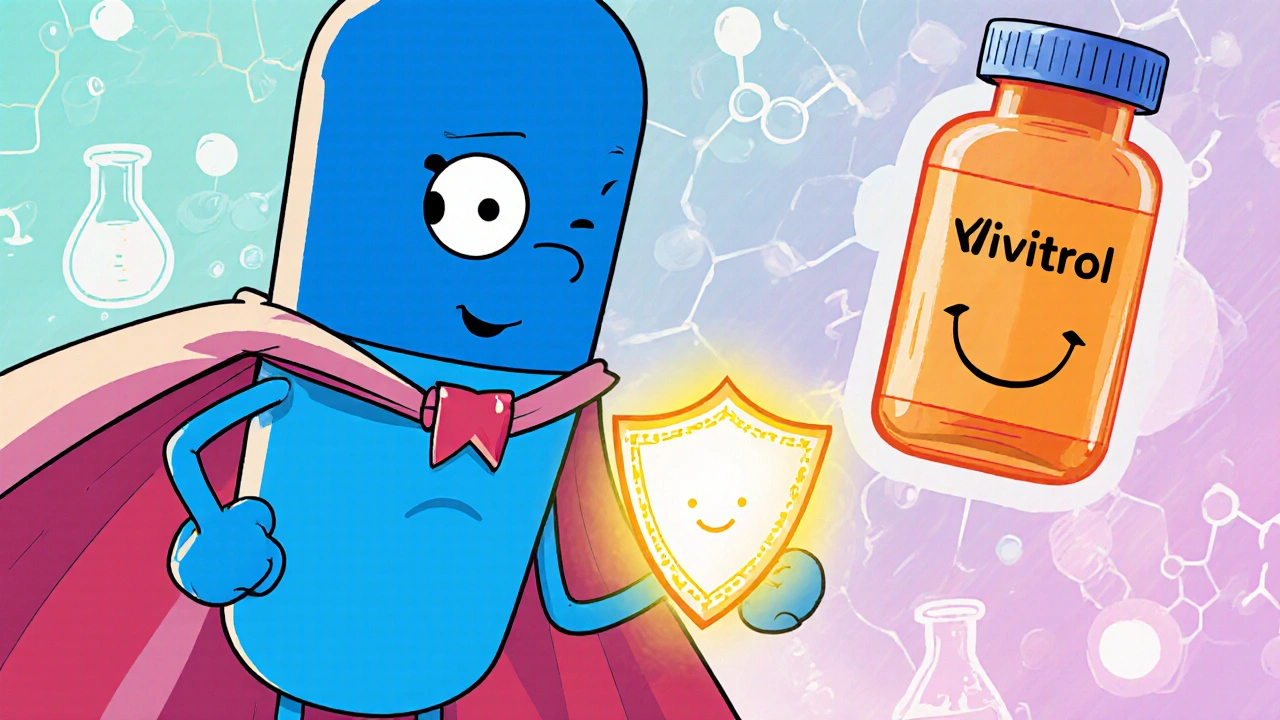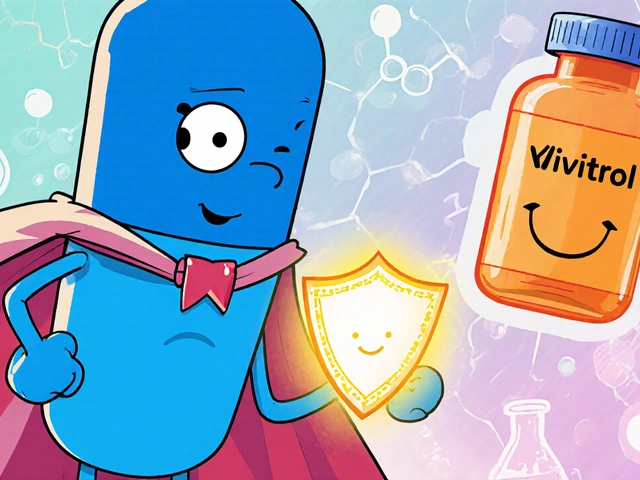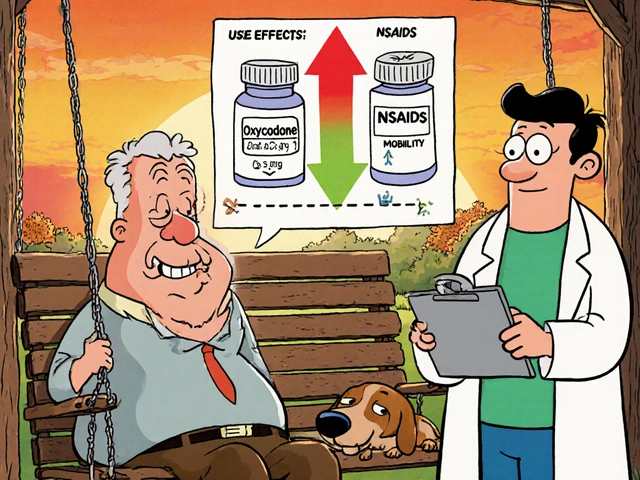
Medication Selector for Substance Use Disorders
Personalized Treatment Guide
Select your primary concern to see which medications align best with your situation.
Top Recommendations
Key Considerations
Cost Comparison
Key Takeaways
- Naltrexone blocks opioid receptors, reducing cravings for both alcohol and opioids.
- Acamprosate works by restoring brain chemical balance after alcohol withdrawal.
- Disulfiram creates an unpleasant reaction to alcohol, making drinking less appealing.
- Naloxone quickly reverses opioid overdose but isn’t used for long‑term maintenance.
- Choosing the right medication depends on dependence type, health profile, and cost.
When treating substance use disorders, Naltrexone is a opioid receptor antagonist medication that helps reduce cravings for alcohol and opioids. It’s available as a daily tablet (Naltrexone hydrochloride) and as a once‑monthly injection (Vivitrol). This article walks through how Naltrexone stacks up against the most common alternatives, so you can decide which option fits your health needs and lifestyle.
What Is Naltrexone (Naltrexone Hydrochloride)?
Naltrexone Hydrochloride is the oral form of Naltrexone, typically prescribed at 50 mg once daily for alcohol dependence and 25-50 mg daily for opioid dependence after detox. By binding to μ‑opioid receptors without activating them, it blocks the rewarding effects of both alcohol‑derived endogenous opioids and external opioids.
How Naltrexone Works
The drug’s antagonistic action dampens the dopamine surge that normally follows drinking or opioid use. Over time, the brain learns that the substance no longer produces pleasure, which can lower cravings and help maintain abstinence. Because it does not produce euphoria, Naltrexone carries low abuse potential.
Common Clinical Uses
- Alcohol dependence: Reduces the desire to drink and helps sustain abstinence after detox.
- Opioid dependence: Prevents relapse after opioid withdrawal; often combined with counseling.
Overview of Main Alternatives
Below are the most frequently prescribed drugs for alcohol or opioid use disorder, each with a distinct mechanism.
- Acamprosate - a calcium‑salt that modulates glutamate signaling to reduce post‑withdrawal cravings.
- Disulfiram - an aldehyde dehydrogenase inhibitor that causes unpleasant flushing when alcohol is consumed.
- Naloxone - an opioid antagonist used acutely to reverse overdose; sometimes combined with buprenorphine for maintenance.
- Buprenorphine - a partial opioid agonist that eases withdrawal while limiting euphoria.
- Methadone - a full opioid agonist used for long‑term maintenance in opioid‑dependent patients.
- Topiramate - an anticonvulsant that may reduce alcohol cravings by affecting GABA and glutamate.
- Vivitrol - an extended‑release injectable form of Naltrexone that provides monthly coverage.
Comparison Table
| Drug | Indication | Mechanism | Typical Dose | Onset | Main Side Effects | Cost (US$ per month) |
|---|---|---|---|---|---|---|
| Naltrexone | Alcohol & Opioid dependence | Opioid receptor antagonist | 50 mg PO daily | 1-2 h | Nausea, headache, liver enzyme rise | 30-45 |
| Acamprosate | Alcohol dependence | Glutamate modulator | 666 mg PO TID | 3-7 days | Diarrhea, metallic taste | 40-55 |
| Disulfiram | Alcohol dependence | Aldehyde dehydrogenase inhibitor | 250 mg PO daily | 30 min (after alcohol) | Flushing, headache, tachycardia | 15-25 |
| Naloxone | Opioid overdose reversal | Opioid receptor antagonist (IV/IM) | 0.4‑2 mg IM/IV as needed | Minutes | Withdrawal symptoms, nausea | 20‑35 (per kit) |
| Buprenorphine | Opioid dependence | Partial μ‑opioid agonist | 4‑24 mg PO daily (or sublingual) | 30‑60 min | Constipation, insomnia | 50‑70 |
| Methadone | Opioid dependence | Full μ‑opioid agonist | 20‑120 mg PO daily | 30‑60 min | QT prolongation, constipation | 30‑45 |
| Topiramate | Alcohol dependence (off‑label) | GABA‑enhancer, glutamate antagonist | 100‑200 mg PO daily | 1‑2 weeks | Paresthesia, cognitive slowing | 25‑40 |
| Vivitrol | Alcohol & Opioid dependence | Extended‑release opioid antagonist | 380 mg IM monthly | 1‑2 h (after injection) | Injection site pain, liver impact | 900‑1,200 |
Deep Dive Into Each Alternative
Acamprosate
Acamprosate helps stabilize the brain’s chemical environment after alcohol withdrawal. It’s taken three times a day, which can be a compliance hurdle, but it has a low interaction profile and works well for patients who crave the “taste” of alcohol rather than the intoxicating effect.
Disulfiram
Disulfiram is the classic “stop‑drinking” drug. Its deterrent effect relies on the patient’s willingness to avoid alcohol completely. It’s not suitable for people with heart disease because the flushing reaction can strain the cardiovascular system.
Naloxone
While not a maintenance medication, naloxone’s rapid reversal of opioid overdose makes it a lifesaver in emergency kits. Some programs pair naloxone with buprenorphine to provide both rescue and maintenance in the same prescription.
Buprenorphine
Buprenorphine’s ceiling effect limits respiratory depression, making it safer than full agonists. It can be prescribed in an office setting, reducing the need for daily clinic visits required for methadone.
Methadone
Methadone remains the gold standard for severe opioid dependence, especially when patients have failed buprenorphine. However, it demands strict clinic monitoring due to cardiac risks and the potential for overdose.
Topiramate
Topiramate shows promise for reducing alcohol cravings, particularly in patients with comorbid migraine or seizures. Cognitive side effects can limit its use in people who need sharp mental performance.
Vivitrol
The injectable version of Naltrexone eliminates daily pill fatigue. Its high upfront cost can be a barrier, but insurance often covers it for patients with documented relapse risk.

Choosing the Right Medication
Deciding which drug to start hinges on three practical questions:
- What substance is the patient primarily using? Alcohol‑focused agents (Acamprosate, Disulfiram) won’t help opioid users, and vice versa.
- Are there liver or cardiac concerns? Naltrexone and Acamprosate require hepatic monitoring; Methadone mandates ECG checks.
- What level of adherence can the patient maintain? Daily tablets suit disciplined patients; monthly injections or weekly buprenorphine may be better for those with adherence challenges.
Discussing these points with a prescriber can tailor therapy to the individual’s medical history, lifestyle, and financial situation.
Potential Side Effects & Safety Tips
All medications carry risk. Here are quick safety pointers:
- Naltrexone: Check liver enzymes before starting; avoid if AST/ALT >3× ULN.
- Acamprosate: Adjust dose for renal impairment; stay hydrated.
- Disulfiram: Never mix with alcohol; watch for severe hypotension.
- Naloxone: Be prepared for abrupt withdrawal symptoms; keep a rescue kit handy.
- Buprenorphine & Methadone: Start low, go slow; monitor for respiratory depression.
- Topiramate: Counsel about possible memory issues; avoid sudden discontinuation.
Frequently Asked Questions
Can I take Naltrexone and Acamprosate together?
Yes, clinicians sometimes combine them for dual‑action - Naltrexone blocks reward pathways while Acamprosate stabilizes glutamate. Monitoring liver function is essential.
Is Vivitrol more effective than oral Naltrexone?
Effectiveness is similar when adherence is perfect. Vivitrol’s advantage is eliminating missed pills, which often translates to better real‑world outcomes.
What happens if I miss a Naltrexone dose?
Missing a single dose usually isn’t dangerous, but it may briefly restore cravings. Resume the regular schedule as soon as possible; don’t double‑dose.
Can Disulfiram be used in people with heart disease?
It’s generally avoided because the alcohol‑induced flushing can trigger arrhythmias and blood‑pressure spikes.
Is buprenorphine safe for pregnant women?
Buprenorphine is considered safer than methadone for pregnancy, but treatment must be closely supervised by an obstetrician and addiction specialist.
Every medication choice should be a shared decision between patient and clinician, based on evidence, side‑effect profiles, and personal circumstances. Armed with this comparison, you’re better equipped to ask the right questions and pick a therapy that aligns with your recovery goals.





